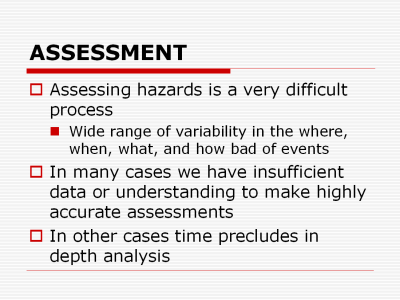| front |1 |2 |3 |4 |5 |6 |7 |8 |9 |10 |11 |12 |13 |14 |15 |16 |17 |18 |19 |20 |21 |22 |23 |24 |review |
 |
Undertaking a hazard analysis is
made the more difficult by the wide variability that exists in:
… what type of hazards you will
actually face versus those that are potential and those that are
possible (but unlikely),
… where the hazard will strike if
it does actually become a threat,
… when the hazard is likely to
occur, and
… with what intensity it will be
experienced.
This is complicated by the reality
that your data may be only partial, and that you may only
partially understand the problem and the probabilities.
Finally, the completion of an assessment is often time constricted by an established cycle for the generation of emergency operations plans. This may preclude in depth technical analysis that might improve the overall quality of the analysis. However, this is not an unusual problem in emergency decision making, as many such decisions are based on sufficient, but not perfect, data. |